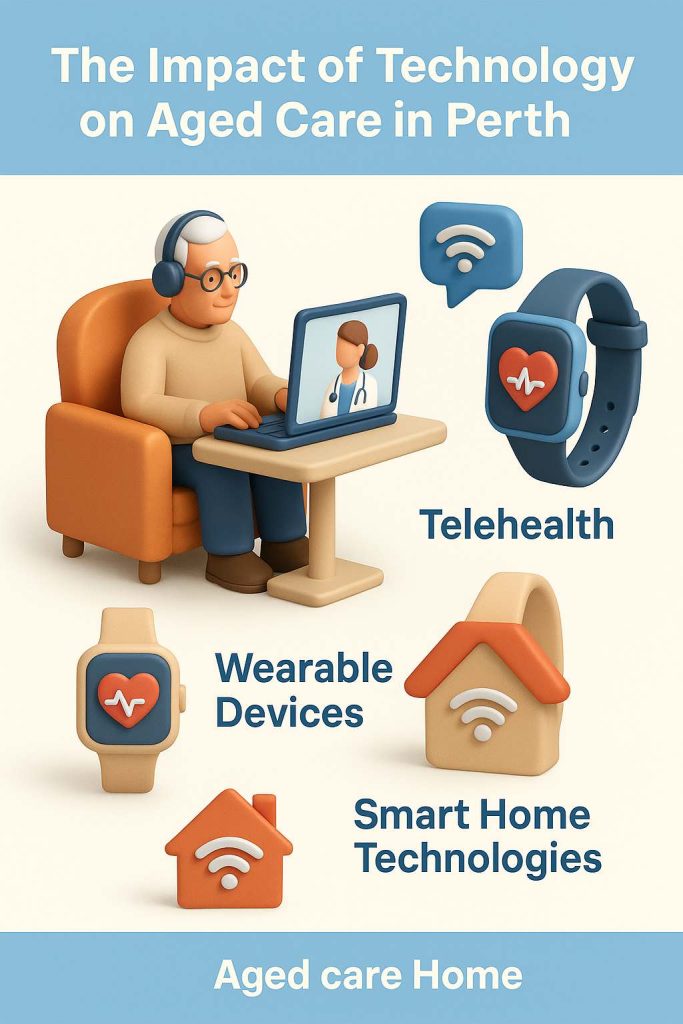Technology is transforming how aged care is delivered across Perth, reshaping support for seniors in both residential facilities and private homes. Innovations such as telehealth, wearable devices, and smart home systems are not only improving clinical outcomes but also enhancing independence, safety, and quality of life. This article explores how these tools are redefining the standards of care for Perth’s ageing population.
Telehealth: Expanding Access to Healthcare
Telehealth has become a cornerstone in modern aged care. Through video consultations, seniors can access general practitioners, specialists, and allied health professionals without leaving their residence. This reduces the burden of travel for elderly patients, particularly those with mobility issues or chronic conditions.
- Early Intervention: Remote monitoring allows clinicians to identify and address health concerns before they escalate.
- Reduced Hospital Visits: By managing conditions from home, seniors experience fewer unnecessary emergency admissions.
- Family Involvement: Telehealth enables families to participate in consultations, improving transparency and shared decision-making.
For aged care providers, telehealth also streamlines scheduling, reduces wait times, and ensures compliance with health protocols, making it a valuable tool for long-term care management.
Wearable Devices: Continuous Health Monitoring
Wearable technology is revolutionising health monitoring in aged care. Devices such as smartwatches, fitness trackers, and medical-grade wearables provide real-time insights into vital signs, activity levels, and even sleep quality.
- Fall Detection: Automatic alerts are sent to caregivers or emergency services when a fall is detected, ensuring rapid response.
- Chronic Disease Management: Continuous tracking of heart rate, blood pressure, and glucose levels helps prevent complications.
- Encouraging Activity: Step counters and mobility tracking motivate seniors to maintain active lifestyles, reducing frailty.
In Perth, aged care facilities adopting wearable technologies have reported improvements in preventative care and reduced response times during emergencies.
Smart Home Technologies: Enhancing Independence
Smart home innovations are enabling seniors to remain independent for longer while staying safe.
- Voice-Activated Systems: Devices like smart speakers allow residents to control lights, appliances, and communication systems without physical strain.
- Automated Safety Features: Motion sensors, smoke alarms, and medication reminders reduce risks associated with forgetfulness or limited mobility.
- Remote Caregiver Access: Family members and carers can monitor daily activities, ensuring seniors are safe while respecting their independence.
These solutions are particularly valuable in community-based settings, where seniors wish to age in place with minimal disruption to their routines.
Aged Care Homes & Technology Integration
The integration of advanced technologies into aged care homes is reshaping service delivery. Facilities that adopt digital care platforms can monitor residents’ health in real-time, maintain accurate electronic care records, and reduce manual paperwork. This allows staff to spend more time engaging with residents and less time on administrative tasks. By embracing telehealth and wearable monitoring, aged care home Perth operators can ensure residents receive timely interventions while maintaining a personalised care approach.
Benefits for Perth’s Ageing Population
The benefits of technological integration extend beyond immediate health improvements:
- Enhanced Safety: Faster response to emergencies and reduced risk of complications.
- Improved Quality of Life: Seniors enjoy greater independence and autonomy.
- Operational Efficiency: Facilities can allocate resources more effectively.
- Community Connection: Digital platforms enable seniors to stay socially connected, reducing isolation.

Challenges & Considerations
While the impact is overwhelmingly positive, challenges remain:
- Digital Literacy: Seniors may require training to use devices confidently.
- Data Security: Protecting sensitive health information is essential.
- Cost: Not all technologies are accessible or affordable without government or institutional support.
Providers must carefully balance these challenges with the clear benefits to ensure technology enhances care without creating barriers.
Conclusion
Technology is not replacing human care—it is enhancing it. From telehealth consultations to wearable health monitors and smart home automation, innovations are setting new benchmarks for aged care in Perth. Families and providers that adopt these solutions can expect improved safety, better health outcomes, and a higher quality of life for seniors. As aged care Perth continues to evolve, technology will remain central to ensuring compassionate, efficient, and sustainable support for the ageing community.
